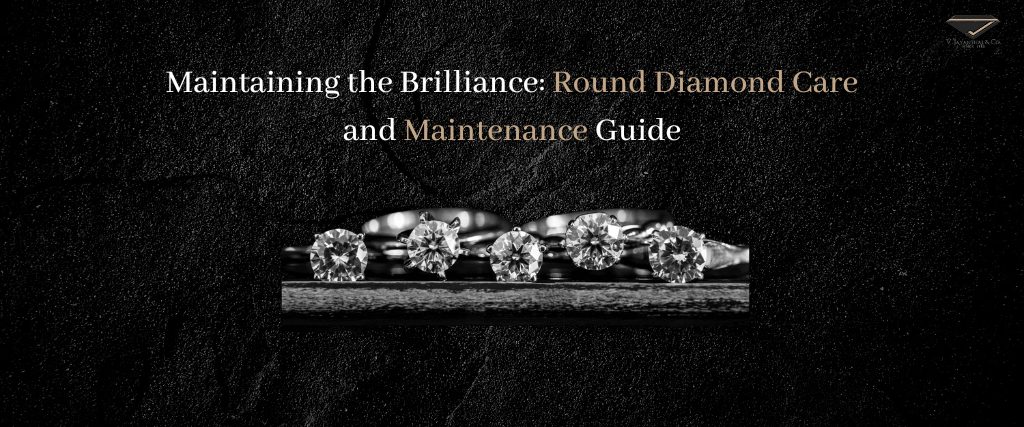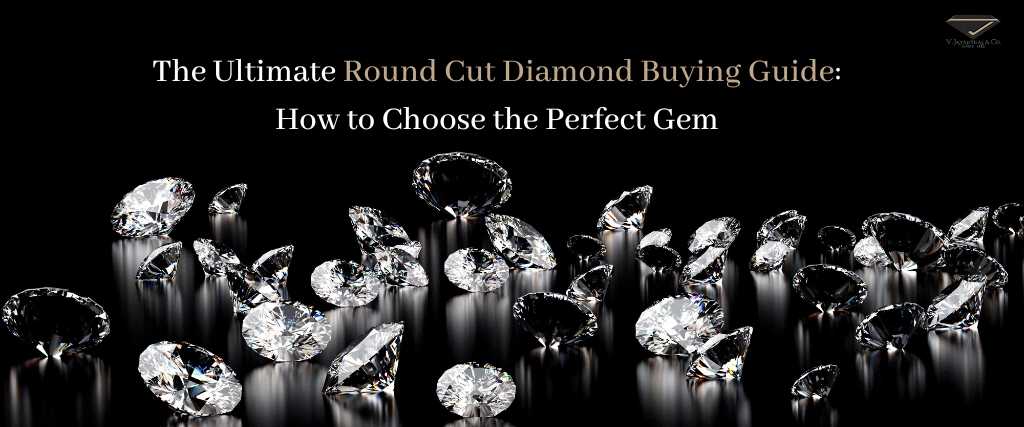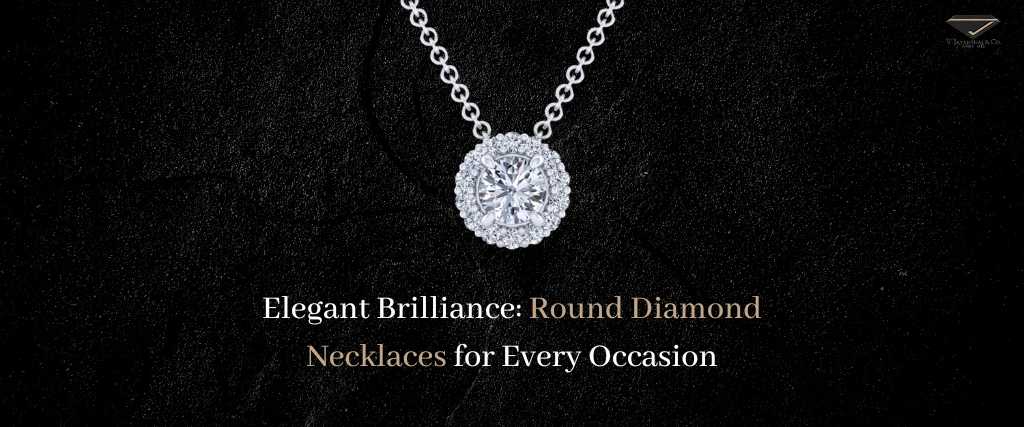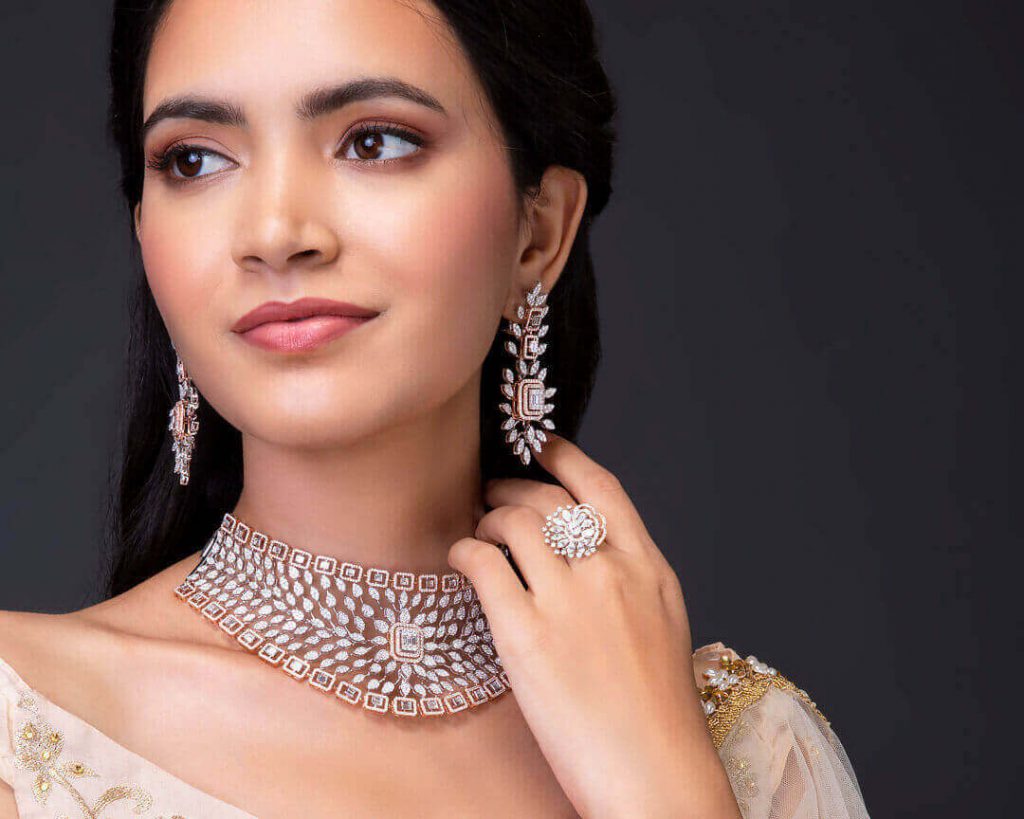
Whether it is our possessions or relationships, we treat them with care if we want them to last and stand the test of time. We love them differently and protect them with everything in our discourse. It takes effort, but it's so damn worth it!
A round-cut diamond engagement ring symbolises love, commitment, and beauty that transcends time. This radiant ring epitomises elegance and sophistication with its circular silhouette and perfectly symmetrical shape. But like any treasured possession, they need round diamond care and frequent inspection.
Think about it: when you put effort into something, like watering your plants or feeding your pet, they thrive and grow into the most marvellous things! It's the same with your engagement ring; when you show love and care, it'll stay as shiny as a disco ball at a party.
So, how do you take care of your round-cut engagement ring?
In this blog, you will become acquainted with some practical and effective tips to care for your precious round diamond engagement ring.
Also Read: Round Diamond: All You Need to Know
Certainly, let's go into more detail about round diamond care:
Harsh chemicals, such as chlorine and bleach, can corrode the metal settings and damage the diamond. Remove your jewellery before swimming or using cleaning products.
When not in use, store your diamond jewellery in a soft pouch or a jewellery box with individual compartments to prevent scratching. Diamonds can scratch other gems and metals.
If your diamond is set in a ring, inspect the prongs regularly to make sure they are holding the diamond securely. Loose prongs can lead to a lost diamond.
Periodically take your diamond jewellery to a professional jeweller for inspection and cleaning.
They can check the settings for wear and tear, make any necessary repairs, and clean the diamond using professional equipment.
Diamonds are hard but not immune to damage. Avoid activities that can subject your diamond to strong impact or pressure.
Remove your jewellery when doing activities like heavy lifting or playing contact sports.
Rapid temperature changes can stress a diamond and potentially cause damage.
For example, don't expose your diamond to high heat (e.g., near an open flame) and then immediately immerse it in cold water.
Be cautious when using ultrasonic cleaners for diamond jewellery. While they can be effective, they may not be suitable for all diamonds.
Some diamonds have fractures or inclusions that can be affected by ultrasonic cleaning, so consult your jeweller for advice.
To protect your investment, consider insuring your diamond jewellery. Check if your homeowner's insurance covers valuable items or consider purchasing a separate jewellery insurance policy.
Over time, a diamond's brilliance may diminish due to daily wear. If you notice a significant loss of sparkle, consider having your diamond professionally re-polished to restore its lustre. This process involves removing a very thin layer from the diamond's surface to eliminate minor scratches and imperfections.
Remember that proper round diamond jewellery care and maintenance will help it maintain its brilliance and beauty for a lifetime. It's essential to handle your round diamond care, and regular maintenance will ensure it continues to shine.
Also See: The Ultimate Round Cut Diamond Buying Guide: How to Choose the Perfect Gem
Cleaning round diamonds is a straightforward process that can be done at home. Here's a step-by-step round diamond cleaning guide:
What You'll Need:
This diamond cleaning method should effectively remove dirt, oils, and residues from your round diamond, restoring its brilliance and sparkle. Regular cleaning helps maintain the diamond's beauty and keeps it looking its best. If you have concerns about your diamond's condition or specific cleaning needs, consider taking it to a professional jeweller for a thorough inspection and cleaning.
Also Read: Elegant Brilliance: Round Diamond Necklaces for Every Occasion
Maintaining the brilliance of round diamonds requires a consistent and detailed care routine. Here's a step-by-step guide to Caring for round-cut diamond jewellery:
Ongoing Maintenance Tips:
By following this detailed round diamond care routine, you can ensure that your diamond jewellery remains in excellent condition, maintaining its beauty and value over time. Proper care and maintenance are essential for preserving the brilliance and allure of your precious diamonds.
Don't forget to have your ring professionally inspected and serviced, clean it on a regular basis, select the best storage, and shield it from potential harm. Avoid common blunders and take extra care if the settings on your ring are intricate.
Your wedding ring made of diamonds will endure with proper maintenance, much like your love for one another.
At V. jayantilal & co., We suggest our customers have a cleaning and stone check every 3 to 4 months. If you’re looking for a round diamond that will last a lifetime, let V. Jayantilal & Co. help.
Our experienced staff can walk you through the different characteristics and show you a variety of setting options that can enhance the diamond’s overall appearance. We want your engagement ring and wedding band combination to bring you eternal happiness.

For its unrivaled brilliance and classic appeal, the round-cut diamond is renowned. It is the most expensive diamond shape. The round-cut diamonds are as exquisite as it is timeless.
In this article, we help you balance budget buying tips to get the perfect blend of quality and value when purchasing round cut diamonds, the process to buy round cut diamonds, and reasons to choose a round cut diamonds engagement ring.
Let's go for it in detail:
The majority of diamonds sold are round cut stones, which are the most common diamond shapes. In fact, data from diamond vendors suggests that around two-thirds of consumers opt for the round cut when choosing a diamond.
With a classic, timeless appearance, round brilliant cuts are often used in engagement rings, necklaces, and other fine jewellery pieces.
Also Read: The Round Brilliant Cut Diamond
The color of a diamond is one of the 4 C’s that determine its selling price. A diamond can range in color quality from colorless to light yellow, with colorless being the most expensive.
The jewellery market will encourage you to shop for colorless diamonds as these are considered to be the best choice. What you might not know is that it is possible to get a diamond that appears colorless to the naked eye but is actually slightly colored, and therefore, is cheaper in price.
A 1-carat diamond ring with near-colourless grading can sell for anywhere between $6,000 to $10,000.
We advise picking a diamond with a Faint diamond grade (K, L, or M) if your objective is to purchase a diamond on a tight budget. These are not noticeably colored to the naked eye.
While having a pristine diamond with no blemishes seems enticing, it’s not always realistic — or necessary.
To save a little on your engagement ring, you can opt for a diamond with inclusions that are not visible to the naked eye.
Their inclusions are only visible with the use of bright light and magnifying tools; hence they look blemish-free to the naked eye.
Due to their lower clarity grading, lower-clarity diamonds are more reasonably priced.
A diamond’s price increases significantly when it reaches the full-carat mark.
For example, a 0.75-carat solitaire engagement ring costs around $1,200 to $1,700. Even if there is just a 0.25-carat difference in size between the diamonds in a 1.00-carat solitaire engagement ring, the price difference is still substantial.
This is because a full carat of a diamond is always sold at a higher price than that of a diamond that is just a little short of the same weight.
The two diamonds look almost identical in size, but the price gap makes the biggest difference.
To help your budget, consider a diamond ring with a lesser carat weight, like this 0.75 carat in a halo setting. There are even a few ways to make your smaller stone appear larger.
Also Read: Round Diamond: All You Need to Know
Gemological laboratories assess diamonds for characteristics like color and clarity; these certificates establish the worth of a diamond and the price at which it should be sold.
There are many gemological labs, including GIA, EGL, DGC, IGI, HRD, and IGL. Each lab has its own standard of grading that differs from one lab to another.
The GIA laboratory is the strictest lab entity and the most well-known certification. Because of this, diamonds that are GIA-Certified are also sold for a higher price compared to diamonds that are certified by other laboratories.
In actuality, other laboratories offer diamonds of the same quality but are less exact in their grading procedures than GIA.
Buying a round diamond involves several steps to ensure a satisfactory purchase. Here's a step-by-step process to guide you through buying a round diamond:
Decide how much you're willing to spend on the diamond. This will help you narrow down your options and focus on diamonds within your price range.
Learn about the 4Cs (Carat, Cut, Color, Clarity) and how they affect a diamond's quality and price. Understanding these factors is crucial for making an informed decision.
Confirm that you want a round diamond shape. While this guide focuses on round-cut diamonds, other shapes are available if you have a specific preference.
Decide on the type of setting you want for the diamond (e.g., solitaire, halo, three-stone) and the metal type (e.g., white gold, yellow gold, platinum).
Ensure the diamond comes with a grading report from a reputable gemological laboratory like GIA or AGS. Review the report to verify the diamond's quality.
Compare multiple diamonds with similar specifications and prices to identify the one that best meets your criteria.
If possible, view the diamond in person at a store or request high-quality images and videos if you're buying online. This allows you to assess the diamond's appearance.
Seek advice from a reputable jeweler or gemologist, especially if you're unsure about your choice. They can offer insightful commentary and helpful suggestions.
Once you've found the perfect round-cut diamonds that meet your criteria, finalize the purchase. Make sure you are familiar with the warranty and return policy.
Complete the transaction, whether it's in-store or online. Be sure to keep all documentation, including the diamond's grading report and purchase receipt.
By following these steps and doing thorough research, you can confidently select the perfect round-cut diamonds that fit your preferences, budget, and ethical considerations.
Round diamond selection tips, three factors play a key role: a 360° surface with stylish facets, offering the most brilliant appearance, and being suitable for all kinds of ring designs. These justifications suggest that round-cut diamonds are best for engagement rings.
Furthermore, round-cut diamonds have a wide, long, and beautiful appearance. The stylish light reflections for round-shaped diamonds are responsible for 57 to 58 facets in triangles, rectangular, straight, and arrow shapes.
Let's see those reasons why round-cut diamond rings are preferable.
Also Read: Round Diamonds for Engagement Rings
In a round diamond cut, there are 360° surfaces available, which make the light's resonating ability robust and flexible. Having the 360° surfaces of the round cut diamond anatomy releases the brilliance affections to all corners and angles, which is the most optimistic to see.
Compared to princess or emerald-cut diamonds, round-cut diamonds throw more wonderful light reflections from their anatomies due to their circled-type circumferences.
So, aside from the bezel set ring design, you can choose round brilliant cut diamonds in a variety of settings to increase their value.
A round diamond offers brilliance because it contains an arrow, heart, triangle, and straight faceting lines on the anatomies.
Facet placements are appropriate in both the internal and external anatomy of the round diamond, which helps to direct brilliance movements in the desired direction.
Let's take an example.
When the lights are entered through the round-cut diamond's table and crown anatomy, the girdle and pavilion surface facets are aligned with the lights and resonate with brilliance in better ways.
The tick point of the round diamond cut helps keep the reflections of the lights in ideal condition. That's why the round diamond looks like a blazing star.
The round diamond cut is a stylish and brilliant cut diamond that gives an attractive light ray. For this reason, all kinds of ring styles are appropriate selections in round-cut diamonds.
Buyers are undoubtedly seeking to make their round diamond cut engagement rings special by choosing them.
There's no limit to selecting only halo or Toi et Moi ring designs for round diamond rings, but if you like to take a solitaire or three-stone pattern, then prefer it. There are 11 types of ring designs available to select round-cut diamonds.
Also Read: Elegant Brilliance: Round Diamond Necklaces for Every Occasion
In the decision and selection decision for purchasing a round cut, there's a gap that is filled when you have sufficient knowledge of the best 4C grades, proportions, and price to spend on it. This round diamond cut guide clears all doubts regarding the purchase.
You can high-quality diamonds at an affordable price range from V. Jayantilal & co., one of the top diamond manufacturing companies in Surat.

If you’re looking for something that says “I love you” most brilliantly, then a diamond necklace is the right choice.
Diamond necklaces come in all shapes and sizes, with a popular style today being the round diamond. Round diamonds have 58 facets and a traditional uniform, symmetrical shape. Its utmost brightness and fire are the result of its superb mechanics.
A round diamond necklace typically refers to a necklace that features a round-cut diamond as its centerpiece or as part of its design. Round-cut diamonds are one of the most popular and classic diamond shapes, known for their brilliance and sparkle due to their precise faceting.
Here are some key points to consider when looking for a round diamond necklace:
The quality of the diamond is essential. Factors such as the diamond's carat weight, color, clarity, and cut (often called the "Four Cs") will influence its overall appearance and price. For a stunning necklace, consider a diamond with good color and clarity grades and an excellent cut.
Setting:
The way the diamond is set in the necklace can vary. Common round diamond necklace settings include prong settings (which allow more light to enter the diamond, enhancing its brilliance), bezel settings (where the diamond is surrounded by a metal rim), and pendant settings (where the diamond hangs from a chain).
Metal:
Consider the metal used for the necklace. White gold and platinum are popular choices for a modern and elegant look, while yellow gold and rose gold provide a more classic and warm appearance.
Chain Length:
The length of the chain can vary, and your choice should depend on your personal style and the neckline of the clothing you plan to wear it with. Common lengths for diamond necklaces are 16 inches (choker length), 18 inches (standard length), and 20 inches or longer for a longer, more dramatic look.
Budget:
Determine your budget before shopping for a round diamond necklace. Diamonds can vary significantly in price based on their quality and size. It's important to find a balance between quality and price that suits your preferences and financial situation.
Certification:
When purchasing a diamond necklace, especially if it's a significant investment, then buy round diamond from a reputable jeweller who provides certification for the diamond's quality. Certificates from organizations like the Gemological Institute of America (GIA) or the International Gemological Institute (IGI) can ensure the diamond's characteristics.
Design:
Explore different necklace designs that incorporate the round diamond. Some round diamond necklaces for men feature a single solitaire round diamond, while others may include additional smaller diamonds or gemstones in the design.
Also Read: Round Diamond: All You Need to Know
Choosing a round diamond necklace has several advantages that make it a popular and timeless choice for many people:
Round-cut diamonds are considered the most classic and timeless of all diamond shapes. They have been popular for centuries and never go out of style. This means that a round diamond necklace is likely to remain fashionable for generations to come.
Round diamonds are renowned for their exceptional brilliance and sparkle. The round shape maximizes the diamond's ability to reflect and refract light, creating a stunning display of light and fire. This makes round diamonds highly sought after for their beauty.
Round diamond necklaces are incredibly versatile. They can be worn with a wide range of outfits and for various occasions, from casual to formal. Whether you're dressing up for a special event or adding a touch of elegance to your everyday attire, a round diamond necklace for women can complement any look.
Due to their popularity, round diamonds are widely available at various price points. You can find round diamond necklaces to fit different budgets, making them accessible to a broad range of consumers.
Round diamonds are known to retain their value well over time. They tend to have strong resale value, and their classic appeal ensures that they remain in demand in the secondary market.
Round diamonds can be incorporated into various necklace styles, whether you prefer a solitaire pendant, a halo setting, a three-stone design, or any other creative arrangement. This flexibility allows you to choose a round diamond necklace that matches your personal style.
Also Read: Round Diamonds for Engagement Rings
If you decide to expand your jewelry collection, round diamond necklaces are easy to match with round diamond stud earrings. This coordinated look can add a touch of elegance to your overall appearance.
Round shapes are often associated with unity and eternity, making round diamond necklaces popular for gifts between loved ones. They can symbolize an unending bond or a significant milestone in a relationship.
Round diamond necklaces come in various styles and designs to suit different tastes and occasions. Here are some common types of round diamond necklaces:
This classic design features a single round-cut diamond set in a simple pendant setting. It showcases the beauty and brilliance of the diamond with minimal distractions.
In a halo necklace, a round-cut diamond is surrounded by smaller diamonds or gemstones, creating a halo effect. This design enhances the overall sparkle and brilliance of the central diamond.
Three-stone necklaces feature three round-cut diamonds set in a line or triangle formation. Each diamond can represent the past, present, and future, making this style popular for anniversaries and milestones.
In a bezel-set necklace, the round diamond is encircled by a metal rim, which holds it securely in place. This design offers a sleek and modern look while protecting the diamond.
A tennis necklace is a continuous strand of round-cut diamonds or gemstones set in a row. It creates a luxurious and elegant look, often worn for formal events.
Station necklaces feature round diamonds spaced at regular intervals along the chain. This style provides a delicate and sophisticated appearance.
Pendant necklaces can have various pendant designs, such as hearts, crosses, stars, or custom shapes, with a round diamond incorporated into the pendant. The round diamond pendant adds a personal touch to the necklace.
In a floating diamond necklace, the round diamond appears to "float" on the wearer's neck without a visible setting, creating a unique and modern aesthetic.
Lariat necklaces have a long chain that can be worn in different ways. They often feature a round diamond or another gemstone as a drop at the end, allowing for versatile styling.
Some necklaces are designed to be versatile and can be worn in multiple ways, such as as a choker, a longer necklace, or even as a bracelet. These necklaces may incorporate round diamonds as part of their adjustable design.
Vintage-style necklaces often incorporate intricate filigree, milgrain detailing, or other vintage elements with round-cut diamonds, creating a timeless and romantic look.
Many jewelers offer customization options, allowing you to create a unique round diamond necklace that matches your specific preferences, from the choice of diamond to the design of the setting.
When choosing a round diamond necklace, consider your personal style, the occasion you plan to wear it for, and your budget. Each type of necklace has its own charm and appeal, so you can find the perfect round diamond necklace to suit your needs and preferences.
Here at V. Jayantilal & Co., we’ve had many years of experience in creating and selling the highest quality diamonds.
When it comes to diamond necklaces, many customers prefer to create their own bespoke diamond pendants. This is done by choosing a certified diamond and setting it separately. Each of our diamonds is vetted in-house by top-level diagnostics to determine the quality and light performance, meaning you will always know the grade of diamond that you’re buying.

Popular Diamond cut are expertly shaped by jewellers to disperse light effectively, giving the stone its vivacious beauty. A diamond comes in a wide range of shapes, sizes, and cuts to match your choice. Each shape of the diamond has unique characteristics. Some diamond shapes are dazzling and modern, while some are vintage designs. At V.Jayantilal & Co., we have a diverse collection of diamond shapes and ensure that the diamond we craft is unique!
If you want to learn more about diamond shapes, this article is perfect for you.
Looking for a classic diamond shape suitable for every occasion? The round diamond shape is the best choice! Round diamond shapes are one of the most well-liked diamond shapes of all.
Almost 75% of engagement rings are round brilliant cut diamond because of the brilliance of 58 facets that reflect light to create sparkle. Its timeless design and ultimate shine make this cut diamond shape more appealing. V.Jayantilal, a top diamond company, provides high clarity round brilliant cut diamonds in Surat.
When buying a round diamond shape, choose an ideal cut, excellent polish, and symmetry to enhance its brilliance.
If you are looking for a vintage-style ring, buying cushion-cut diamond is a perfect choice! Cushion diamonds are square and rectangular with a beautiful rounded off-cut design that is still wowing brides today.
Always check the depth to be under 70% and the table to be in the same range when purchasing a cushion-shaped diamond. It will help to ensure brilliance and fire throughout the diamond's depth. Cushion-shaped diamonds hide the inclusion very well and exhibit sparkle.
For the one who wants to stand out and love something unique, a pear-shaped diamond is an ideal choice. It is a modified brilliant that combines marquise and oval shapes. It creates an asymmetrical shape with one rounded and one pointed end.
A pear-shaped diamond is also known as a teardrop shape. Pay close attention to the severity of the bow tie when buying the pear-shaped diamond to make sure that it doesn't tarnish the appeal of the diamond. The symmetry grade is also vital when it comes to pear-cut diamonds. Pear-shaped gems have 58 facets. Diamond jewellery made in this shape is trendy due to its distinctive appearance.
Are you looking for a diamond that is suitable for a hustling lifestyle? The radiant diamond shape is a perfect fit. A radiant-shaped diamond is a combination of an emerald and a round brilliant, exhibiting maximum sparkle. Triangular and kite-shaped facets accentuate the charm of a radiant diamond.
The radiant diamond uses the brilliance of a round cut and has a cropped corner and additional facets that give it an emerald-like appearance. The radiant cut is a rectangular-shaped diamond and a cut corner made with 70 facets.
The Asscher shape got its name from the I.J. Asscher diamond company in 1902 in Holland. The Asscher is widely considered similar to an emerald diamond due to its long step-like cut. However, the emerald has a rectangular shape, while the Asscher diamond has a square shape.
The Asscher diamond features long facets, a high crown, and a smaller table, so it shines more brilliantly than emerald-shaped diamonds. It is the popular choice among people who love vintage and antique styles. An Asscher diamond features 58 facets, while a patented royal Asscher diamond has 74 facets.
After the round brilliant, the princess-cut diamond shape is square and the second most popular diamond cut. It is popular due to its brilliance and distinctive cut. Compared to a round diamond shape, the price per carat of this diamond is lower.
It combines round brilliance with a square pointed edge. The colour emitted from the princess-cut diamond is unique. It not only displayed the distinct colour in the centre but also in each of the corners as well.
It had 57 to 76 facets. For maximum sparkle and fire, the arrangement is similar to that of a round diamond stone. Due to their brilliance, they tend to blend well with almost all engagement rings.
If you are looking for a traditional look with a contemporary twist, oval diamond shapes are a great choice! Its elongated shape gives rings an eye-snatching appeal to the finger. As with a pear-shaped diamond, an oval diamond shape also consists of a bow tie. An oval diamond shape consists of 55 facets.
If you are looking for a good piece of diamond without spending a hefty amount, an emerald-shaped diamond is a perfect choice! An emerald-shaped diamond is rectangular and has long, step-like cuts.
Emerald shapes are the ideal choice for the ring, earrings, and pendants! When buying an emerald-shaped diamond, pay extra attention to the clarity of the diamond. An emerald diamond shape is a preferred choice for anyone desiring to buy a large stone with a limited budget.
Undoubtedly, the
is the most beloved shape of all because of its premium cut, shine, and eye-catching appeal. The heart-shaped diamond features a modified version of the brilliant cut.
Heart-shaped diamonds are the ultimate sign of love. When buying a heart-shaped diamond, always opt for a diamond that appears evenly shaped, brilliant, and has a good length-to-width ratio.
If you are looking for a larger stone at the same carat, check out the marquise-shaped diamond! The marquise-shaped diamond got its name from the marquise of the pompadour. It has a long and narrow cut in shape like a football. When buying a marquise-shaped diamond, always pay attention to the symmetry and design of the diamond.
For many, selecting the ideal diamond can be challenging. At V.jayantilal & Co., we strive to offer our clients the highest quality diamonds in Surat. We hope this information was helpful to you with the basic understanding of the diamond shape.
At V.jayantilal, the collection of the diamonds features different diamond shapes, ranging from round to fancy shapes.

